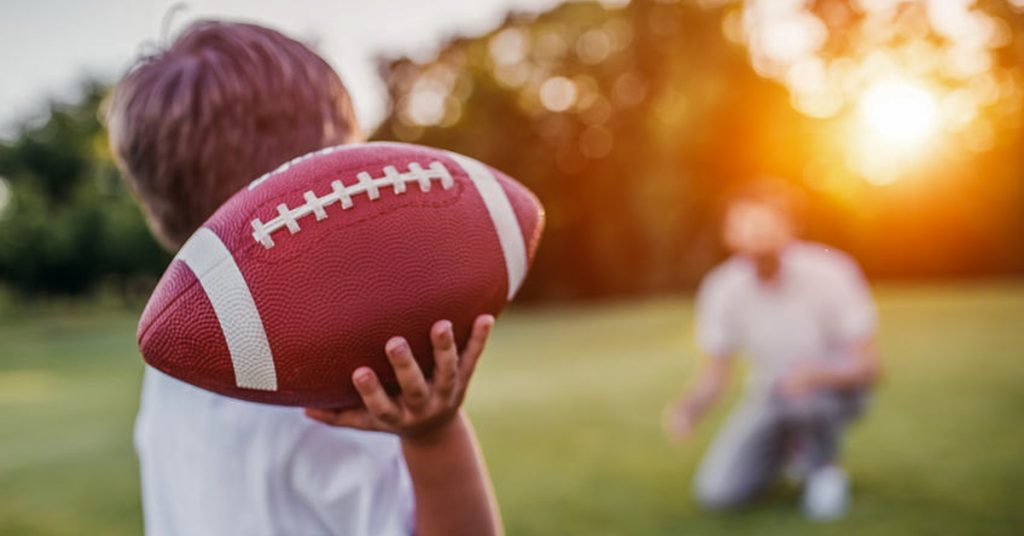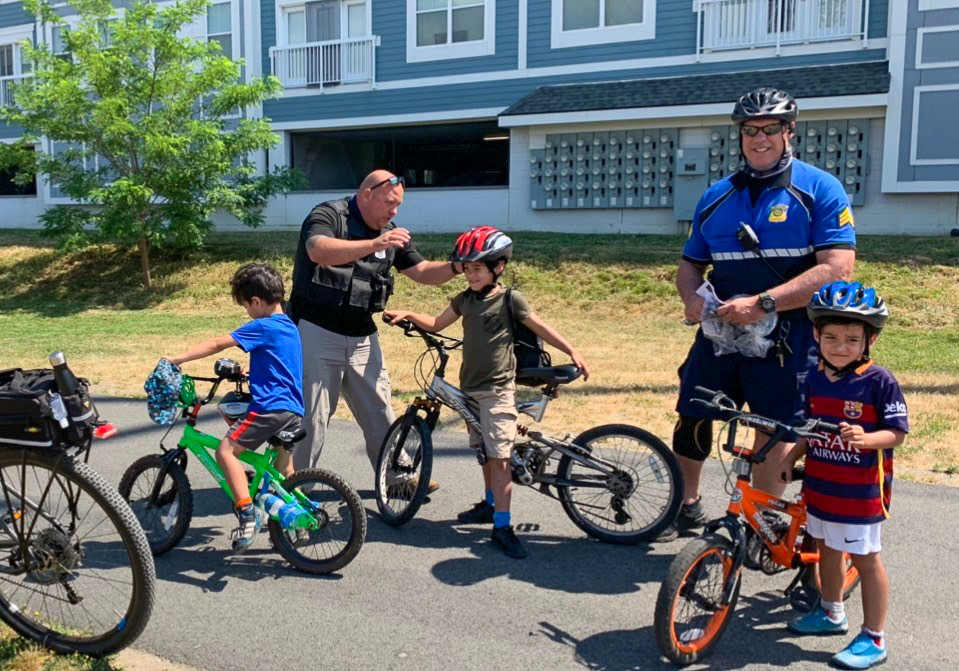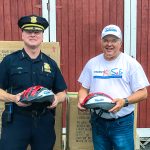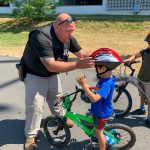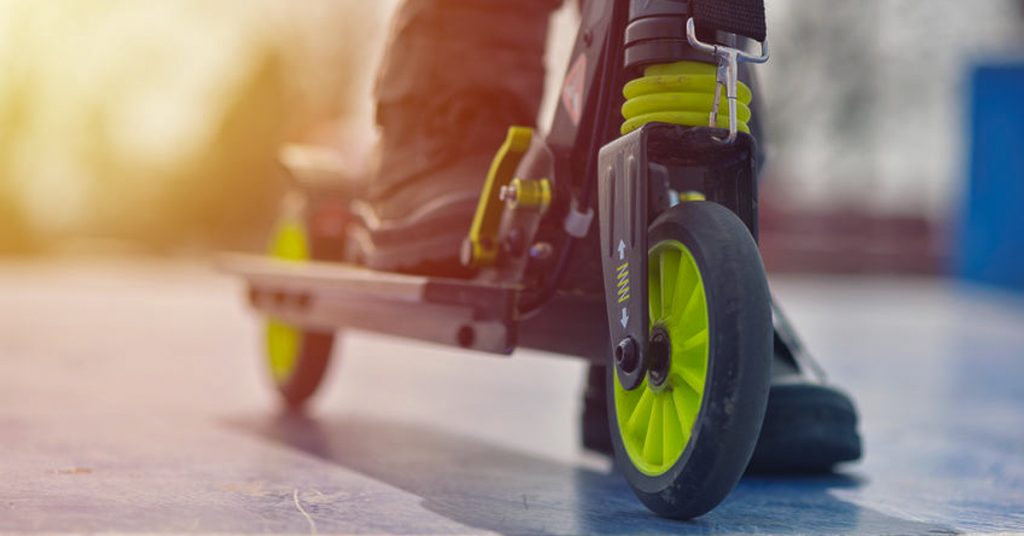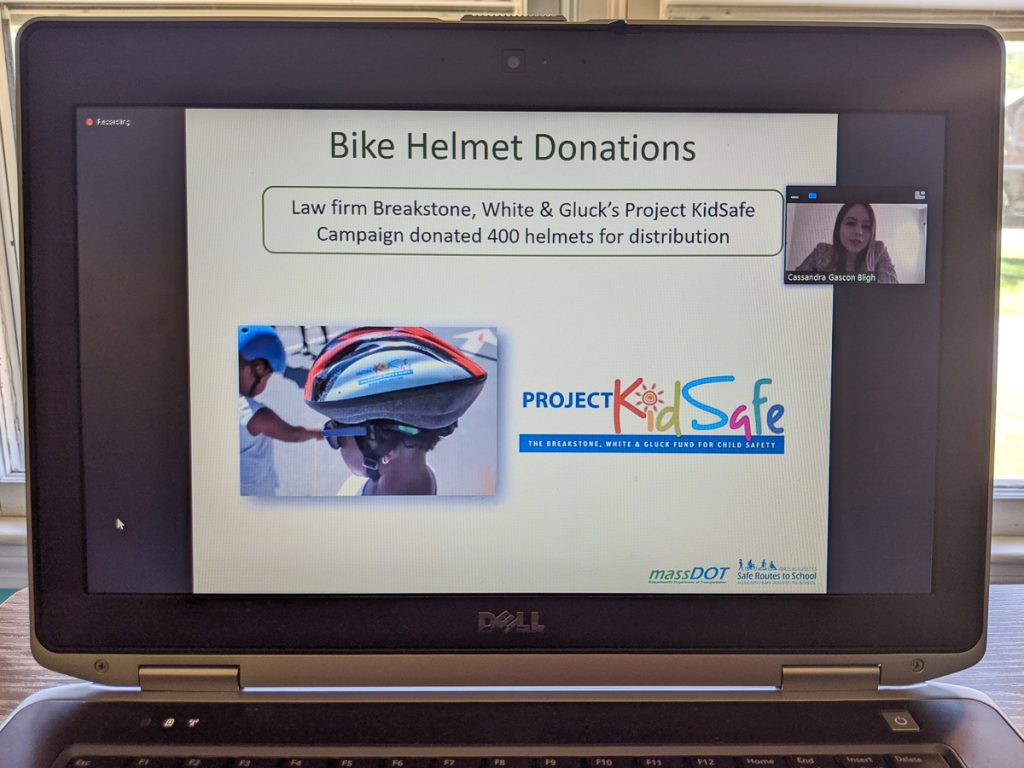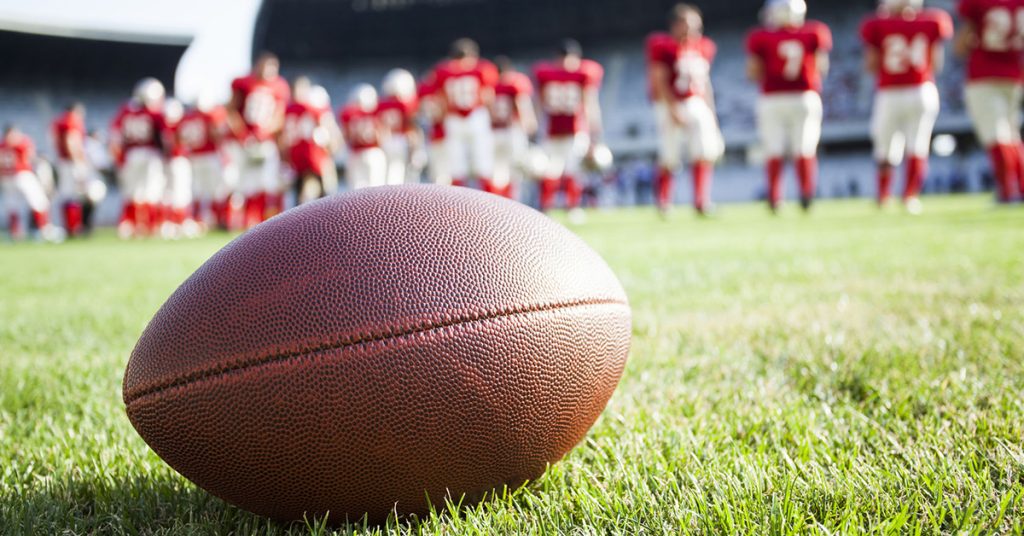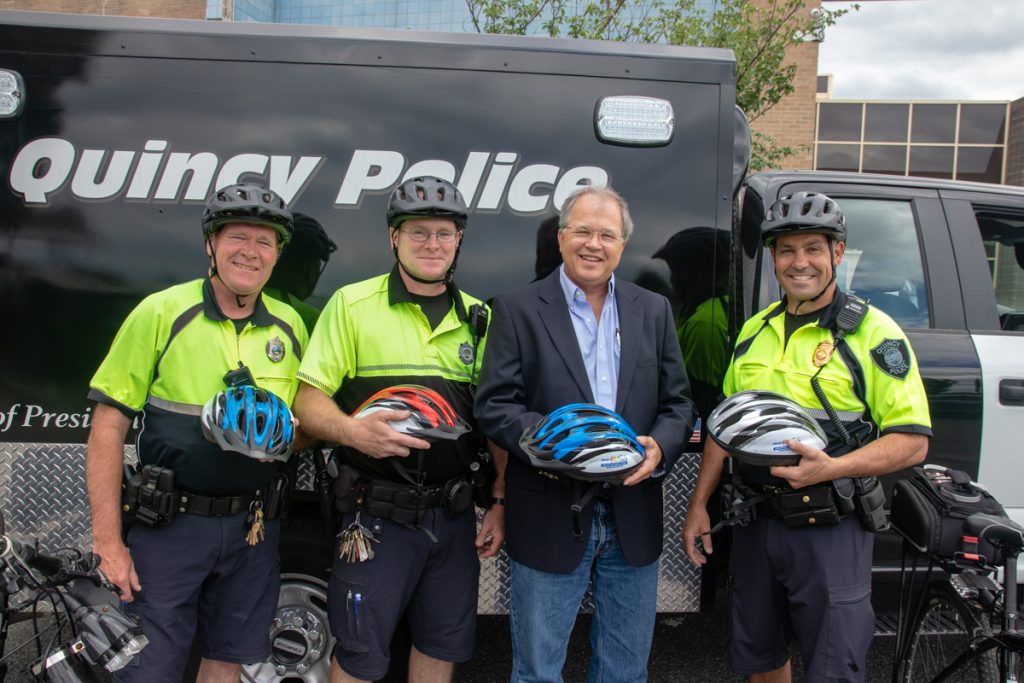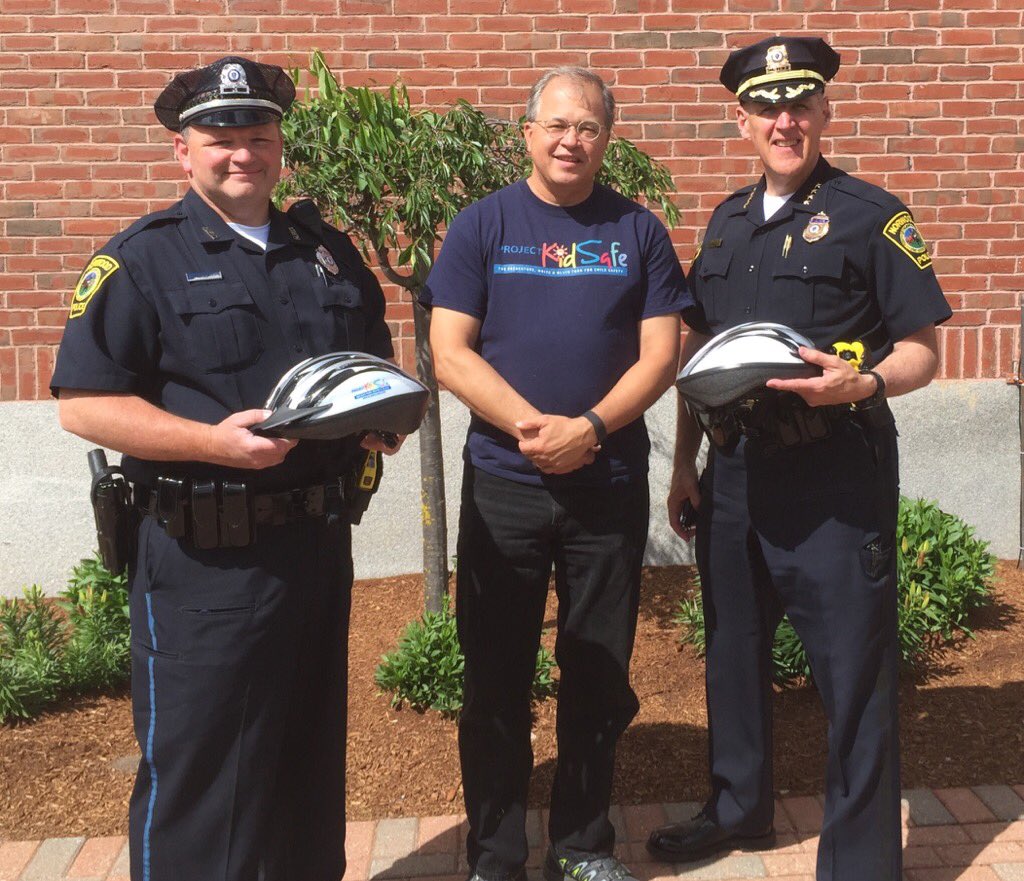Head Injury
Fewer Children Visiting Hospitals for Sports-Related TBI
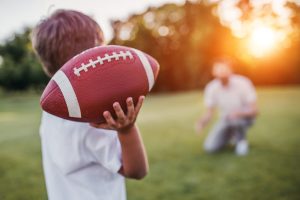
There has been a drop in child sports-related TBI visits to ERs, according to the CDC.
According to new research, fewer children are visiting the hospital for sports and recreation-related traumatic brain injuries. This is being largely driven by changes on the football field.
After a decade of rising injuries and the passage of state concussion laws, fewer children have been participating in youth football, contributing to the reduction in injuries. Going forward, the researchers are focusing on studying safer play techniques which could limit contact in football. They will also continue investigating head injuries in other sports, such as soccer and basketball, where the numbers didn’t change significantly.
The Centers for Disease Control and Prevention (CDC) released the research in a recent weekly report. Researchers analyzed data from the National Electronic Injury Surveillance System-All Injury Database.
What the Researchers Learned
The number of children visiting the hospital for sports and recreation-related traumatic brain injuries fell 32 percent from 2013 to 2018.
Researchers attribute this to changes in youth football programs across the U.S. Since 2010, participation has fallen 24 percent. Meanwhile, there was a 39 percent decline in football TBI visits from 2013 and 2018.
This was an encouraging sign. Previously, from 2001 to 2013, there had been a 200 percent increase in children suffering football-related traumatic brain injuries and ER visits. This was among children age 5-17.
While football-related TBI ER visits decreased, there was not significant movement in TBI ER visits for basketball and soccer, two other contact sports.
The CDC and researchers are also studying safer tackling techniques in football. Several sports leagues have also introduced new approaches which limit contact during practice. These include the National Federation of State High School Associations and its member states, along with two major youth football programs.
Concussions and Traumatic Brain Injuries
According to the CDC, a TBI is caused by a bump, blow or jolt to the head. It may be a penetrating head injury that disrupts the brain function. A concussion is a “mild” traumatic brain injury. A concussion may lead to brief changes in mental function and consciousness. Those injured may not realize they have a concussion and learning to recognize potential symptoms can save their life.
When it comes to your child, physicians, pediatricians, schools and caregivers have a responsibility to follow certain steps if they play sports and suffer a concussion or repeated concussions.
Massachusetts Concussion Protocols: Preventing Injuries and Caring for Students
CDC researchers noted that many children can recover from a sports and recreation-related TBI within 4 weeks. However, there is a continued focus on reducing long-term effects on a child’s brain development. Recovery must be carefully monitored.
Massachusetts and other states have passed laws to guide schools and sports leagues on how to prevent and treat injuries. Schools, leagues and coaches have a responsibility to follow the concussion protocols.
In Massachusetts, schools must provide students with training on how to recognize a concussion. Students must be removed from play if a concussion is suspected. They can only return with a doctor’s note. Read more about the Massachusetts concussion protocol on our website.
About Breakstone, White & Gluck – Boston Concussion Lawyers
Breakstone, White & Gluck and our Boston head injury lawyers represent clients after traumatic brain injuries and concussions caused by negligence. If you or a loved one has been injured, receive medical attention right away. Then, learn your legal rights.
For a free consultation with one of our lawyers, call 800-379-1244 or 617-723-7676. You can also use our contact form.
Breakstone, White & Gluck and Everett Police Make Donations for Bike Safety
Breakstone, White & Gluck’s Project KidSafe campaign recently supported the Everett Police Department’s work to protect children on bikes. In June, our lawyers donated roughly 100 bicycle helmets to Everett Police Chief Steve Mazzie and his officers. Attorney David W. White was there to deliver the helmets.
This is the fifth year we have partnered with Everett Police so we know their commitment to children and bike safety runs deep. But we were really inspired this year. Officers wasted no time. They began distributing the bicycle helmets right away and found many children who could benefit from our donation. Great job to Everett Police again!
- Everett Police Chief Steve Mazzie and Attorney David W. White of Breakstone, White & Gluck.
- Attorney David W. White delivers our Project KidSafe helmets to the Everett Police Department in late June.
- Courtesy: Everett Police Facebook.
- Courtesy: Everett Police Facebook.
- Courtesy: Everett Police Facebook.
About Breakstone, White & Gluck
At Breakstone, White & Gluck, our Boston personal injury lawyers specialize in representing those injured by the negligence or wrongdoing of others. Our attorneys are advocates for safe cycling and encourage all cyclists to wear bicycle helmets to protect against head injuries. To promote safe riding, Breakstone, White & Gluck has donated 30,000 bicycle helmets across Massachusetts through our Project KidSafe campaign.
Breakstone, White & Gluck has also been recognized as a Silver-Level Bicycle Friendly Business by the League of American Bicyclists.
Safety Tips for Using Children’s Scooters in Massachusetts
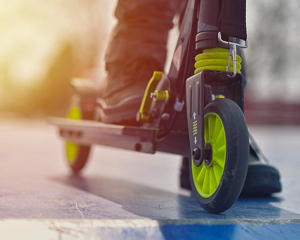
Safety tips for children’s scooters.
Children are eager to find fun activities this summer. In response, many parents have purchased new scooters online. As you open the box, remember to approach your child’s scooter as you would a bicycle. Make sure you have an age-appropriate and safe scooter model, along with a safety helmet.
Pre-Purchase: Read Product Materials
Before you buy, carefully read the product description. For children, plan to buy an age-appropriate non-motorized scooter. Check out online reviews and ask friends about their experiences purchasing scooters. Then, search for product recalls on the Consumer Product Safety Commission website. This is essential because at times, online vendors have been caught selling recalled products. Your child could be seriously injured on a recalled scooter.
Try to purchase a new scooter for your child. While bicycles can be passed down and refurbished, children usually wear their scooters out fairly well, especially the thin, fold-up models. If you do find a hand-me-down scooter, do a thorough inspection before giving it to your child. Locate the model number and check the recall database.
Post-Purchase: Inspect Your Delivery
When the scooter arrives, check that you have received the right model number and all the parts. Nothing should be broken or cracked. Register the scooter with the manufacturer to receive product recalls and other updates. Bicycles, skateboards and scooters all contain small parts and screws. Because your child probably rides daily, we suggest keeping the box. Scan the instructions and product support number so they are easily accessible.
Purchase a Helmet
As part of our Project KidSafe campaign, Breakstone, White & Gluck encourages children to wear bicycle helmets to protect against head injuries. Your child should also wear a helmet every time they ride a scooter. Take time to make sure the helmet is properly-fitted so your child is comfortable wearing it.
This is a suggestion and a requirement. A little background: Under Massachusetts law, children 16 and younger must wear helmets on bikes and scooters, as well as other riding toys.
The bicycle helmet law has been in place longer. In 1994, the state of Massachusetts approved a bicycle helmet law for children age 12 and younger. Then, in 2004, Massachusetts expanded the helmet law to children age 16 and younger on bikes, as well as scooters, skateboard, inline skates and manually-propelled wheeled vehicles. These laws are M.G.L. c. 85, § 11B and M.G.L. c. 85, § 11B1/2.
Some parents keep separate helmets for scooters and bikes. It is also acceptable for children to use one helmet, so long as it meets the federal safety standard for bicycles, properly fits and is in good condition. One reminder though: if your child wears one helmet, expect it to wear faster. Be prepared. Stowaway an extra helmet in your garage.
Look for helmets to meet this safety standard, U.S. Consumer Product Safety Commission (16 C.F.R. part 1203). These helmets are designed to protect against skull fractures and severe brain injuries sustained in bicycle accidents and falls. For more information, read the CPSC’s article, “Which Helmet for Which Activity?”
Driveway Safety
Many scooter accidents happen in or near driveways. Think about how you can protect your children while they ride. One idea is you can purchase driveway fencing. You can buy light-weight brightly colored fencing which retracts when you are done playing. Another strategy is you can park your cars between the children’s play area and the road.
Steer Clear of Large Vehicles
Even quiet streets see large vehicles, including SUVs, delivery trucks and trash vehicles. These vehicles can be deadly near young children on scooters. When a large vehicle appears, teach your child to move to a safe location (this may be your front lawn, your driveway, the sidewalk or the side of the road). Children are safest stepping off the scooter until the vehicle turns off the engine and parks or departs. Drivers backing up can be the most dangerous for children on scooters. Have your children wait inside while you back in or out of your driveway.
Bright Colored Clothing
Buy your child a brightly colored vest, shirt or jacket to wear when they ride near your home or around the neighborhood. Drivers don’t expect scooters – they move differently than bicycles or pedestrians – and you want them to really see your child. To reinforce the message, you can also wear brightly colored clothes as you walk along your child. Everyone is safer when they are more visible to traffic.
Park Scooters at Night
For safety, children should park their scooters at night. Drivers have a responsibility to look and operate with reasonable care. But the truth is more accidents occur at night and drivers are less likely to see bikes and scooters. Children’s scooters may have neon stickers, but these are hardly visible in night traffic.
Non-Motorized Scooters for Children
Say no to motorized scooters. The American Academy of Pediatrics (AAP) has advised against motorized scooters for children under 16. Powered scooters are associated with three times as many severe injuries to children in the U.S., according to a New York Times article on the study.
Scooter Injuries. In the 2008 study, children were more likely to suffer concussions and severe head injuries on motorized scooters. Leg injuries also increased.
More recently, in 2017, the CPSC reported non-motorized scooters were associated with the most injuries among two age groups, children 12 and younger and children under 15. That year, non-motorized scooters caused roughly 20 percent of injuries in both age groups and four deaths of children between 4 and 8 years old. All four children were riding scooters near their family’s home or driveway.
Defective Scooters. Do not assume your child was doing something wrong if the scooter starts to break or a piece falls loose. Manufacturers have had to recall defective scooters on many occasions. Report the incident to the manufacturer. Your report may confirm other reports and prompt them to issue a recall to prevent other scooter accidents and injuries. This is how the process works and it only works if consumers come forward with safety complaints.
Discard Scooters Carefully. If your child wore out their scooter, it’s not safe for use and you should disassemble it. This way, it will not injure another child.
About Breakstone, White & Gluck – Boston Personal Injury Lawyers
At Breakstone, White & Gluck, our Boston personal injury lawyers represent those who have been injured by negligence and recklessness. We are also committed to protecting against head injuries through our Project KidSafe campaign, donating 30,000 bicycle helmets to Massachusetts children since 2013.
We urge families to buy scooters carefully. Always buy a helmet. Always check for product recalls before you buy. Always carefully inspect the scooter when it arrives. Then, after you have taken these steps, you’re ready to enjoy the last few weeks of summer, watching your child ride their new scooter safely.
If you or your child are injured by negligence, please take time to learn your legal rights. For a free legal consultation, contact Breakstone, White & Gluck at 800-379-1244 or 617-723-7676 or use our contact form.
Massachusetts Safe Routes to School Recognizes Project KidSafe Bike Helmet Donation
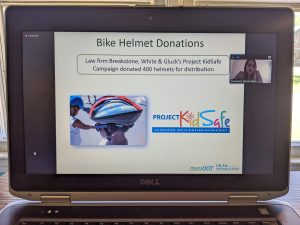
For the 6th year, Breakstone, White & Gluck and our Project KidSafe campaign are pleased to support Massachusetts Safe Routes to School. Once again, our attorneys have committed to donating 400 bicycle helmets to Safe Routes. From there, the Safe Routes coordinators will give the helmets to low-income children who want to participate in bike safety training and bike rodeos.
This morning, Massachusetts Safe Routes to School held its annual awards ceremony to honor schools and teachers which have excelled in reaching their walking and biking goals for children. Stephanie Pollack, secretary and CEO of the Massachusetts Department of Transportation (MassDOT), was the featured speaker. Before announcing the awards, Massachusetts Safe Routes to School thanked Breakstone, White & Gluck for our donation.
This is Massachusetts Safe Routes to School’s 15th anniversary. For those who don’t know, Massachusetts Safe Routes to School is a federally funded initiative of the MassDOT. Over 15 years, it has offered biking and pedestrian safety program to children in 237 communities and reached more than 420,000 students. Schools are committed to the programming. Safe Routes now has 920 partner schools. View this year’s awards list.
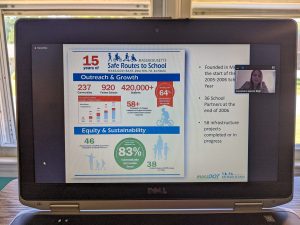 About Breakstone, White & Gluck – Commitment to Bike Safety
About Breakstone, White & Gluck – Commitment to Bike Safety
The Boston personal injury lawyers at Breakstone, White & Gluck are committed to safety and preventing head injuries. Through our Project KidSafe campaign, we have donated 30,000 children’s bicycle helmets across Massachusetts. We founded our campaign in 2013 and have since partnered with Massachusetts Safe Routes to School, local police departments, bicycle committees and community groups. Our goal has been to work with community partners who really care and are committed to bicycle safety and preventing head injuries.
In Massachusetts, cyclists under age 17 must wear bicycle helmets. But every cyclist is encouraged to wear a helmet. We hope you are never injured on a bike, but you can recover from many injuries. Head injuries can be fatal and it is important to protect yourself.
Commit to wear a bicycle helmet every time you ride. Helmet use has been estimated to reduce the chances of head injury by 50 percent and the chances of head, face or neck injury by 33 percent, according to the Insurance Institute for Highway Safety.
Massachusetts Concussion Legislation Would Ban Students In Grade 7 or Younger from Playing Football
Should students have to wait until they finish 7th grade to play football in Massachusetts? Lawmakers are being asked to consider legislation to delay the start of play to protect players from concussions.
“An Act for No Organized Head Impacts to Schoolchildren,” has been filed by State representatives Paul A. Schmid III (D-8th Bristol) and Bradley H. Jones Jr. (R-20th Middlesex). The legislation would ban children in 7th grade or younger from playing or practicing any form of organized tackle football. Schools would be held accountable and face fines for violations:
- $2,000 for each violation
- $5,000 for subsequent violations
- $10,000 when serious physical harm result to participants
Children would be allowed to play flag football or any form of football which does not involve tackle play. The proposal does not include any other sport.
Causes of Concussions
The Centers for Disease Control and Prevention (CDC) define a traumatic brain injury (TBI) as a disruption to the brain caused by a blow or jolt to the head. Concussions are considered a mild TBI, which can result in a brief change of mental alertness or consciousness. A severe TBI can result in a longer period of unconsciousness or mental change.
Symptoms may not be immediately evident after a concussion, especially if the person or those around them are not familiar with the symptoms, which can include an inability to think clearly, memory problems, feeling dazed and mood, behavior or personality changes. Headaches, nausea and vomiting can also set in.
Beyond the sports field, falls are the leading cause of concussions, according to the CDC. Adults over age 65 and children under 14 are most likely to suffer a fall leading to a head injury. Car crashes are the third leading cause of concussions, followed by being struck in the head by an unspecified object, such as in a construction site accident or by violence.
Concussions can also happen on the sports field. Not every contact necessarily results in a concussion, but to identify injuries, Massachusetts and other states have already passed concussion education and training laws. Known as “return to play” laws, these require high school and middle school students to be examined by a medical professional before they can participate in sports again.
Research on Concussions and the Impact on Younger Football Players
New research shows there is a measurable impact when younger children play football. In a study of 26 football players – all age 12 – Wake Forest researchers found changes in the corpus callosum, which joins the two sides of the brain and integrates cognitive, motor and sensory functions. The players underwent MRIs to examine the changes prior to the three-month season and three months after the season concluded. They were compared to 22 other students who did not participate in contact sports.
Players who suffer a concussion need proper rest and treatment so they can properly heal and to reduce the chance for another injury. Researchers have documented this risk; one study found high school and college students who sustained concussions were four to six times more likely to suffer a second injury (Source: McGill University in Montreal).
Concussion Legislation Filed in Other States
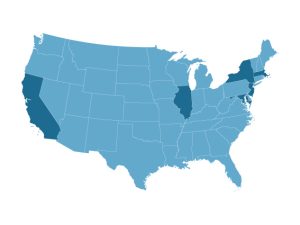
Lawmakers in Massachusetts and five other states have proposed banning tackle football for children younger than 12 or for those in seventh grade or younger. Data from Shape America.
Massachusetts isn’t taking the field alone on concussions. At least five other states are also debating tackle football bans for children under age 12. These states include Illinois, California, Maryland, New York and New Jersey, according to Boston.com. But none of the proposals are on track to reach state governors.
All 50 states already have “return to play” laws aimed at reducing youth sports-related concussions, according to the National Conference of State Legislatures. Washington state was the first to pass such a law in 2009. By 2015, every other state had enacted a similar law.
In most states, these laws mandate concussion awareness training and education to prevent concussions among student athletes. According to Shape America, 48 states require students suspected of having concussions to sit out at least 24 hours.
Arizona and South Carolina allow students back on the field the same day with a doctor’s approval.
Passed in July 2010, the Massachusetts concussion law requires parents, volunteers, coaches and school nurses to receive specialized concussion awareness training. This is to help them recognize concussion symptoms and help students receive treatment as soon as possible.
As in other states, the Massachusetts law requires medical clearance before students can return to sports. Schools are then required to maintain detailed record-keeping related to a student’s injury and progress in the classroom and on the field. The law is M.G.L. ch.111 §222. The Code of Massachusetts Regulations is 105 CMR 201.000.
All middle and high schools which offer sports through the Massachusetts Interscholastic Athletic Association (MIAA) must follow the concussion safety law.
The Patriot Ledger Newspaper: Breakstone, White & Gluck Donates 200 Bicycle Helmets to the Quincy Police Department
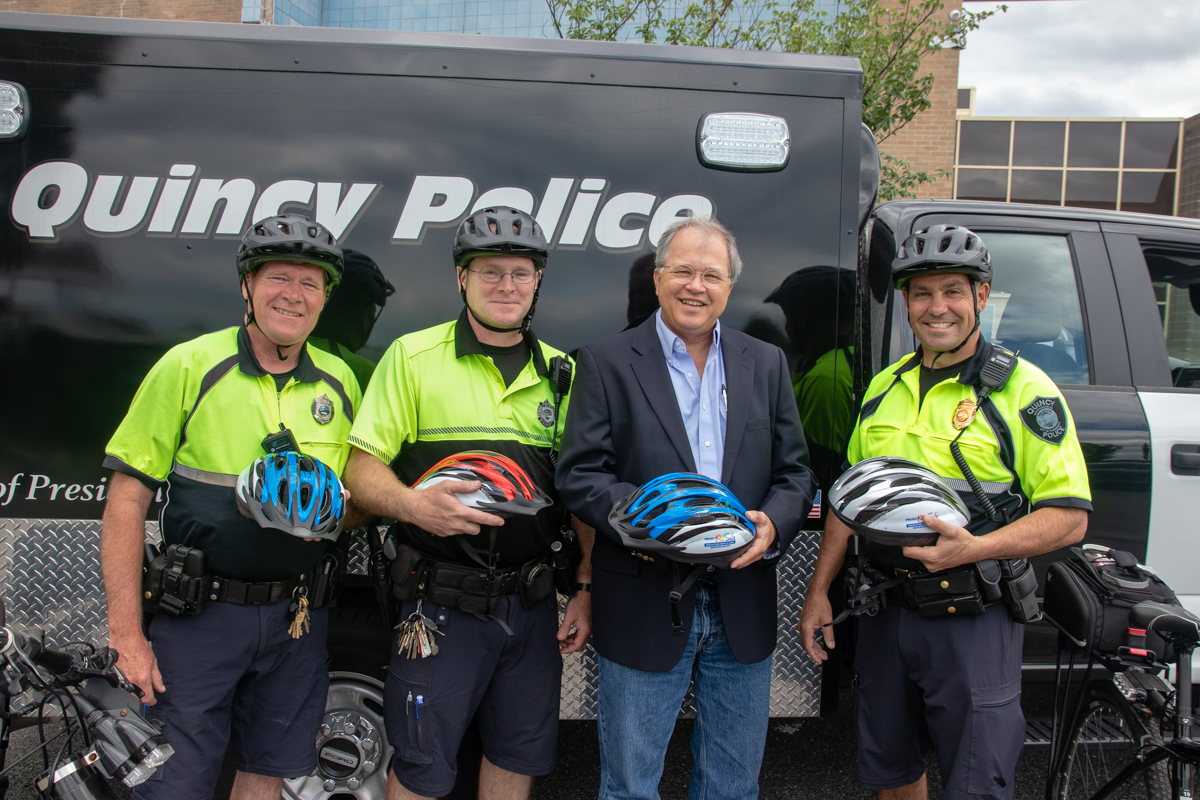
Attorney David W. White with members of the Quincy Police Department Bike Patrol: Officer White, Officer Whedbee and Lieutenant Bina.
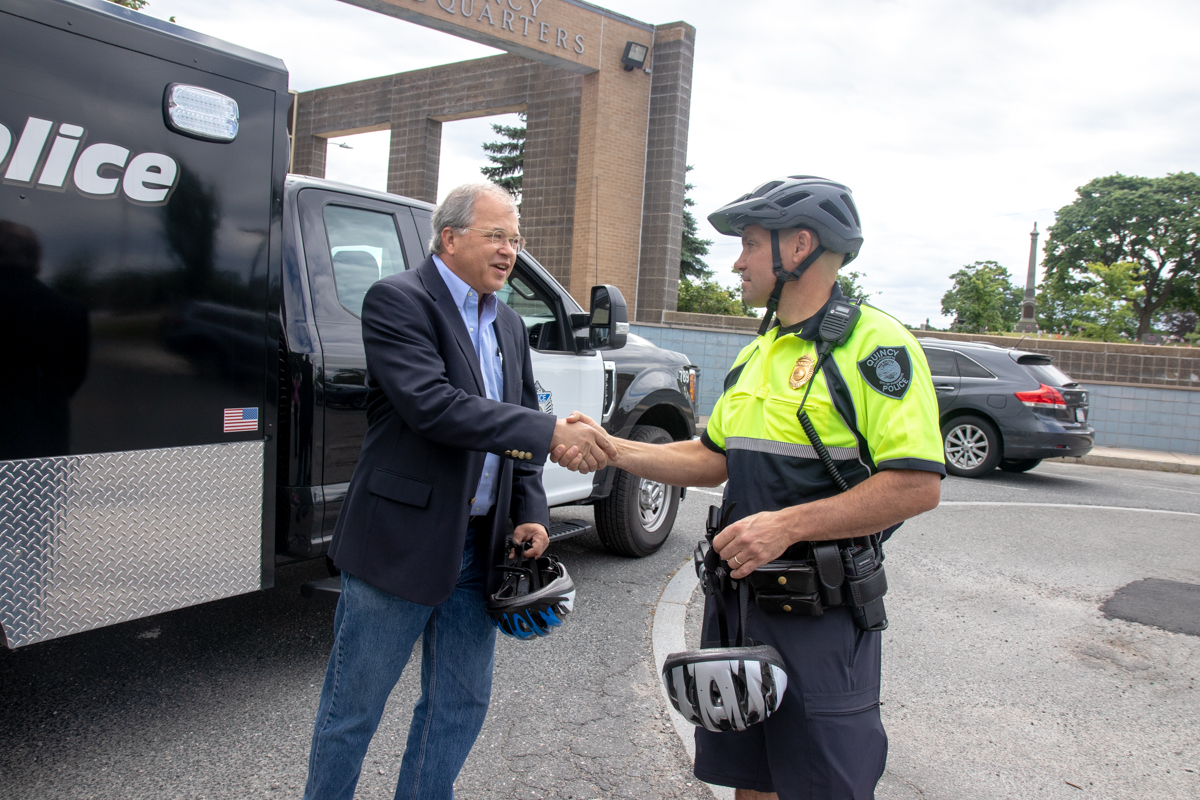
Attorney David W. White and Lieutenant Bina of the Quincy Police Department.
As part of our Project KidSafe campaign, Breakstone, White & Gluck was pleased to make a donation of 200 bicycle helmets to the Quincy Police Department this year. Attorney David W. White visited Quincy Police Department headquarters on June 14th and had a nice opportunity to speak to members of the Quincy Police bike patrol.
Read more about the donation in the Patriot Ledger newspaper (June 19, 2018).
Learn more about our attorneys and our Project KidSafe campaign.
More NFL Players are Self Reporting Concussion Symptoms
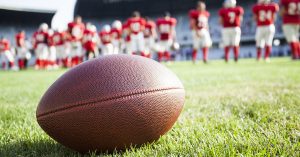 Professional football players face a high risk for concussions, far greater than most of us. But Rob Gronkowski’s concussion a few weeks ago was a reminder that concussions can happen when we least expect them, even in the middle of a big game. And when they do, the game must stop.
Professional football players face a high risk for concussions, far greater than most of us. But Rob Gronkowski’s concussion a few weeks ago was a reminder that concussions can happen when we least expect them, even in the middle of a big game. And when they do, the game must stop.
Much has changed over the past decade, as hundreds of former NFL players have sued over head injuries. Every state now has a concussion protocol for student athletes. In Massachusetts, students, coaches and parents are now trained to recognize concussion symptoms and how to respond. But others should also be aware of the risks. Beyond the playing field, concussions can happen in car accidents, construction accidents, falls and other situations.
Concussions are a mild Traumatic Brain Injury (TBI) which are often caused by an impact to the head. Concussions can be hard to recognize at first, with some initial symptoms mirroring the flu.
According to the Centers for Disease Control & Prevention (CDC), symptoms include:
- Headache or pressure in the head
- Temporary loss of consciousness
- Nausea and vomiting
- Fatigue and dizziness
- Confusion
- Slurred speech and/or a delayed response
Other symptoms may take a few hours or days to show, including poor concentration, memory problems, personality changes and sleep disturbances.
The NFL has specialists watch players for concussion symptoms. Last year brought a 16 percent increase in concussion reports. Yet there was one positive. Players self reported and initiated 28 percent of concussion evaluations in preseason and the regular season. This was up 9 percent. The NFL released these preliminary figures in January.
Though it was hard to see the Patriots fall in the Super Bowl, the increase in self-reported concussions is still a win. Here are some tips for concussion prevention beyond the football field:
Sports
Passed in 2010, Massachusetts’ concussion safety law requires students, parents, coaches and anyone involved in high school sports to be trained on how to identify the symptoms of a concussion. Students must be taken out of the game if they are injured and cleared by a doctor before they can return. Schools are required to report the number of concussions to the state.
This law provides a good foundation for educating the public about concussions and will protect students. If you are not a parent or student, you can find information about concussions online. The Mayo Clinic offers this resource.
Car Crashes
A high-impact traffic crash can cause head injuries and bruising you may not immediately see. Always receive medical treatment after a car accident. If you were traveling with a young child, it is essential. They may not be able to communicate the nature of their injuries. This is critical because car accidents are the leading cause of TBI-related deaths among children and young adults ages 5 to 24, according to the CDC.
Falls
Falls are the leading cause of TBI, with children and the elderly the most vulnerable, according to the CDC. Nearly half – 47 percent – of all individuals with TBI injuries who go to the emergency room, hospital or die have fallen.
There are a few steps you can take to prevent a concussion from being left untreated.
Adults who care for elderly parents can talk to them about the risks associated with falls and symptoms of a concussion.
First, let your parent know they should visit their medical doctor or an emergency room immediately after a fall. Then, do not assume they will. Many people are reluctant and unsure about going to a doctor. Let your parent know they can always call you and you will drive them.
Parents can protect young children by gating off staircases and laying down slip guards to prevent slips and falls. This is especially important for wooden staircases.
Stay informed about concussion policies at schools and daycare programs. Make sure your emergency contact information is up to date so the school can always reach you. On playgrounds, make sure your child is playing over soft material, not pavement. Give them an extra hand when venturing on new equipment for the first time. Steer them toward something else if they are not quite ready.
About Breakstone, White & Gluck
The Boston personal injury lawyers at Breakstone, White & Gluck specialize in representing clients in cases involving traumatic brain injuries. For a free legal consultation, contact our firm at 800-379-1244 or 617-723-7676 or use our contact form.
Project KidSafe: Bicycle Helmet Donations for Norwood Police and Bikes Not Bombs
As we continue our 2017 Project KidSafe campaign, Breakstone, White & Gluck wants to share a few recent bike helmet donations and some bicycle safety tips for children over the Memorial Day weekend.
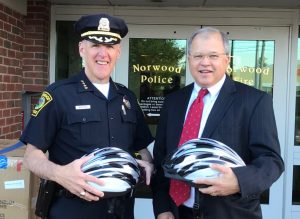 Breakstone, White & Gluck was pleased to donate 100 bicycle helmets to the Norwood Police Department for the third year. Attorney David W. White delivered the helmets to Norwood Police Chief William G. Brooks III in early May. The Norwood Police Department now plans to distribute the helmets at a bike safety event being planned for June. If you live in Norwood, watch local community calendars.
Breakstone, White & Gluck was pleased to donate 100 bicycle helmets to the Norwood Police Department for the third year. Attorney David W. White delivered the helmets to Norwood Police Chief William G. Brooks III in early May. The Norwood Police Department now plans to distribute the helmets at a bike safety event being planned for June. If you live in Norwood, watch local community calendars.
It was also our pleasure to donate 170 bicycle helmets to Bikes Not Bombs in Jamaica Plain. Founded in 1984, Bikes Not Bombs works to repair used bikes locally and internationally to help individuals. This was the fifth year we have made this donation.
In Boston, Bikes Not Bombs offers a popular Earn-A-Bike program, which teaches children and teenagers how to ride in the city and repair bikes during a six-week session. Students are taken on group rides and get to help refurbish a bike to take home. Each graduate also takes home a new bicycle helmet from our Project KidSafe campaign.
In addition to Earn-A-Bike, Bikes Not Bombs offers other programs for teenagers in the Boston area, aimed at helping them learn safe cycling skills and bike repair. These programs include Girls in Action and BOCA, a program which combines cycling and community action.
You may see a Bikes Not Bombs tent at local community events this Spring and Summer. The organization collects and rehabs bikes for people without access to transportation in Africa, Latin America and Caribbean. Bicycles provide a means of transportation and help individuals fight political oppression and rebuild communities. If you have an extra bike, consider making a donation. Learn more on the Bikes Not Bombs website.
Through our Project KidSafe campaign, Breakstone, White & Gluck has donated over 10,000 bicycle helmets to children in the Boston area since 2013. During the fifth year of our campaign, our goal continues to be to encourage children to wear a helmet every time they ride.
Study after study has shown wearing a helmet is the most effective way to protect you or your child from a head injury if you fall or are in a bicycle accident. Yet studies also show children are not always wearing helmets, even though many states have laws requiring helmet use for children. In Massachusetts, the law says children who are 16 years old and younger must wear helmets.
Earlier this month, the Today Show reported more than 400,000 kids are hurt each year while riding bikes, scooters, skateboards and skates or roller blades. Of the children injured on bikes, only 68 percent were wearing bike helmets, according to their parents.
As we approach the Memorial Day weekend, here are some reminders for helping young cyclists ride safe:
- Wear a bicycle helmet. Select a helmet for your child which meets the Consumer Product Safety Commission standard. Properly adjust it so it has a snug fit and will provide protection in case of a fall or a bicycle accident. If you need help, there is an instructional video on our website. Then, tell your child it is important to wear a helmet every time they ride. Be sure to wear your helmet, too. These last two steps are the most important.
- Wear neon and bright colors. Stock your child’s drawers up with neon t-shirts and other clothing. You want to help your child stand out to traffic, pedestrians and other cyclists. Search “neon clothing” on Amazon.com for ideas.
- Ride with your children. Enjoy cycling with your children and teach them safe riding techniques at the same time.
- Control your bicycle. Keep both hands on your handlebars and tell your child to do the same. Keep school backpacks light or use a bike basket. Encourage children to always look ahead and not turn around to talk to you or other cyclists while pedaling.
- No cell phone use. Do not let your child ride with their cell phone. If they must, make sure it is packed away in a backpack and turned off. Cell phone use is likely to lead to a bicycle accident.
- Check equipment. Before they ride, check your child’s bike. Make sure tires are properly inflated and that the brakes work.
- Avoid riding at night. Children should not ride at night until they are older and have more experience on the roads. If you ride at night, be aware that you are required to use lights and reflectors under Massachusetts law.
Breakstone, White & Gluck Donates 120 Children’s Bicycle Helmets to Dedham Police and Dedham Bike Rodeo
Breakstone, White & Gluck was pleased to donate 120 children’s bicycle helmets to the Dedham Police Department and the Dedham Bike Rodeo this year. This was our fourth year participating in the rodeo and Attorney Reza Breakstone was on hand to fit children for new helmets and answer questions about bicycle safety.
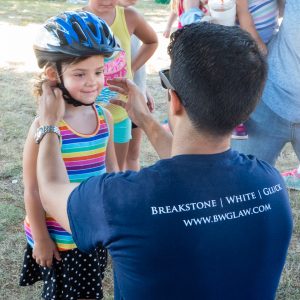 The Dedham Police Department and the Dedham Parks & Recreation Department organize the annual rodeo, which is always held at the Endicott Estate. We always expect warm weather, but this year was especially hot and we were worried children may not come out. There was no cause for concern. We still had many parents and grandparents bring children, and children from local childcare programs stop in. Attorney Breakstone still fit about 75 children ages 4 to 10 for new bicycle helmets. Dedham police officers will give the rest to children who need one.
The Dedham Police Department and the Dedham Parks & Recreation Department organize the annual rodeo, which is always held at the Endicott Estate. We always expect warm weather, but this year was especially hot and we were worried children may not come out. There was no cause for concern. We still had many parents and grandparents bring children, and children from local childcare programs stop in. Attorney Breakstone still fit about 75 children ages 4 to 10 for new bicycle helmets. Dedham police officers will give the rest to children who need one.
Breakstone, White & Gluck donated the bicycle helmets through our Project KidSafe campaign, which has now donated over 10,000 helmets to children in eastern Massachusetts. We started our safety campaign in 2013. The Dedham Bike Rodeo was one of our first events and it is always rewarding to return each year.
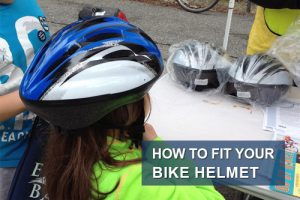 How to Fit Your Child’s Bicycle Helmet
How to Fit Your Child’s Bicycle Helmet
If you or your child need help fitting a helmet, we want to share this video. Putting a bicycle helmet on your child is a critical step in protecting them from a serious head injury. By wearing a helmet, cyclists reduce their chance for head injury by 50 percent, according to the Insurance Institute for Highway Safety. Other studies have shown it provides even more protection so it is important for all cyclists to wear one, every time they ride. Read More
Breakstone, White & Gluck Donates 100 Children’s Bicycle Helmets to Norwood Police, Norwood Bike Safety Day
With a donation from Breakstone, White & Gluck, Norwood Police distributed free bicycle helmets to children who needed one at Norwood Bike Safety Day over the weekend.
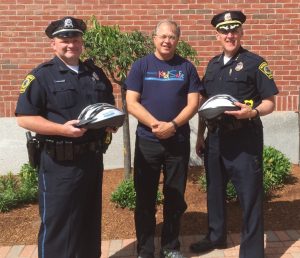
Attorney David W. White with Norwood Police Chief William G. Brooks III and Officer Paul Murphy. Photo courtesy: @ChiefBrooksNPD.
This is the second year Breakstone, White & Gluck has donated helmets for distribution on Bike Safety Day, which was held at the Balch Elementary School. Bike Safety Day was organized by the Norwood Police Department and the Norwood Bike Depot, a local bicycle shop. Norwood Police school resource officers and the Mountain Bicycle Unit were out to meet the community.
Parents and children had the opportunity to learn how to fit a bicycle helmet directly from police officers. Bicycle safety inspections were also offered for all ages.
Breakstone, White & Gluck donated the bicycle helmets as part of our Project KidSafe campaign, which has donated over 10,000 bicycle helmets in eastern Massachusetts. We launched our campaign in 2013, with a simple goal: to help children ride their bicycles safely and to prevent head injuries.
In Massachusetts, cyclists 16 years old and younger are required to wear a bicycle helmet. By wearing a helmet, cyclists can reduce their chance for head injury by 50 percent, according to the Insurance Institute for Highway Safety. Yet many cyclists still do not wear helmets.
Breakstone, White & Gluck will make several bicycle helmet donations to local police departments this year. In recent weeks, we have made donations to the Cambridge Police Department as well as the Boston Police Department and others. These are important partnerships because local police departments regularly encounter children who are riding without helmets. By donating a bicycle helmet, we hope to encourage safe riding and create an opportunity for a positive interaction between police and youth.
Bicycle Safety Resources for Parents
 We invite you to visit our website and view our bike safety page. There is a video on how to properly fit a bicycle helmet as well as articles on cyclists’ rights in Massachusetts and understanding how car insurance impacts cyclists.
We invite you to visit our website and view our bike safety page. There is a video on how to properly fit a bicycle helmet as well as articles on cyclists’ rights in Massachusetts and understanding how car insurance impacts cyclists.
About Breakstone, White & Gluck
Breakstone, White & Gluck is a Boston personal injury law firm which is committed to the safety of all bicyclists in Massachusetts. We have over 100 years combined experience representing bicyclists injured by the negligence of others. If you, or a member of your family, has been injured in a bicycle incident, please feel free to contact us for a free legal consultation at 800-379-1244 or 617-723-7676 or use our contact form. Thank you and RIDE SAFE!


